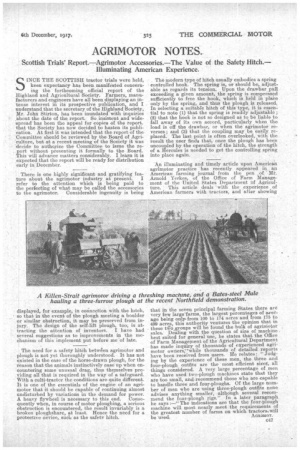AGRIMOTOR NOTES..
Page 25

If you've noticed an error in this article please click here to report it so we can fix it.
Scottish Trials' Report.—Agrimotor Accessories.—The Value of the Safety Hitch.— Illuminating American Experience.
S INCE THE SCOTTISH tractor trials were held, " keen expectancy has been manifested concern ing the forthcoming official report of the Highland and Agricultural Society. Farmers, manufacturers and engineers have all been displaying an intense interest in its prospective publication, and I understand that the secretary of the Highland Society, Mr. Johia Stirton, has been inundated with inquiries :about the date of the report. So insistent and widespread has been the appeal for copies of the report. that the Society has now decided to hasten its publication. At first it was intended that the report of the Committee should be reviewed by the Board of Agriculture, but at a recent meeting of the Society it was 'decide to authorize the Committee to issue the re • port without presenting it formally to the Board. This will advance matters considerably. I learn it is expected that the report will be ready for distribution early in December.
There is one highly significant and gratifying feature about the agrimotor industry at present. I refer to the attention which is being paid to the perfecting of what may be called the accessories to the agrimotor. Considerable ingenuity is being displayed, for example, in connection with the hitch, so that in the event of the plough meeting a boulder or similar obstruction, it may be preserved from injury. The design of the self-lift plough, too, is attracting the attention of inventors. I have had several suggestions as to improvements in the mechanism of this implement put before me of late.
The need for a safety hitch betsvSen agrimotor and plough is not yet thoroughly understood. It has not existed in the case of the horse-drawn plough, for the reason that the animals instinctively ease up when encountering some unusual drag, thus themselves providing all that is required in the way of a safeguard. With a culti-tractor the conditions are quite different. It is one of the essentials of the engine of an agrimotor that it should be capable of continuing almost undisturbed by variations in the demand for power. A heavy flywheel is necessary to this end. Consequently when, in course of motor ploughing, a serious obstruction is encountered, the result invariably is a broken ploughshare, at least. Hence the need for a protective device,, such as the safety hitch.
The modern type of hitch usually embodies a spring
• controlled hook. The spring is or should be,,adjustable as regards its tension. -Upon the drawbar pull exceeding a given amount, the spring is compressed sufficiently to free the hook, which is held in place only by the spring, and thus the plough is released. In selecting a suitable hitch of this type, it is essential to note (1) that the spring is readily adjustable ; (2) that the hook is not so designed as to be liable to fall away of its own accord, particularly when the load is off the drawbar, or when the agrimotor 'reverses; and (3) that the coupling may be easily replaced. The last point is often overlooked, With the result the user finds that, once the plough has been uncoupled by the operation of the hitch, the strength of a Hercules is needed to get the controlling spring into place again.
An illuminating and timely article upon American agrimotor practice has recently appeared in an American farming journal from the pen . of Mr.
• Arnold Yerkes, of the Office of Farm Management of the United States Department -of Agriculture. This article deals with the experience of American farmers with tractors, and after showing that in the seven principal farming States there are very few largelarms, the largest percentages of average being only. from 100 to 174 acres and from 175 to 499 acres, this authority ventures the opinion that in these two.groups will be found the bulk of agrirriotor sales. Dealing with the question of size of machine • best suited for general use, he states that the Office of Farm Manageinent of the Agricultural Department has made inquiry of thousands of experienced agrimotor owners,"while thousands of detailed reports have been received from users. He relates: "Judging by the experience of these men, the three and four-plough outfits are the most efficient sizes, all things considered. A very large percentage of men who have used two-plough machines state that they are too small, and recommend those who are capable to handle three and four-ploughs. Of the large number of men who are using three-plough outfits none advises anything smaller, al-the-ugh several recommend the four-plough rigs." In a later paragraph he says :—" The indications are that the four-plough machine will most nearly meet the requirements of the greatest number of farms on which tractorsswill be use4 AGIMMOT.
































